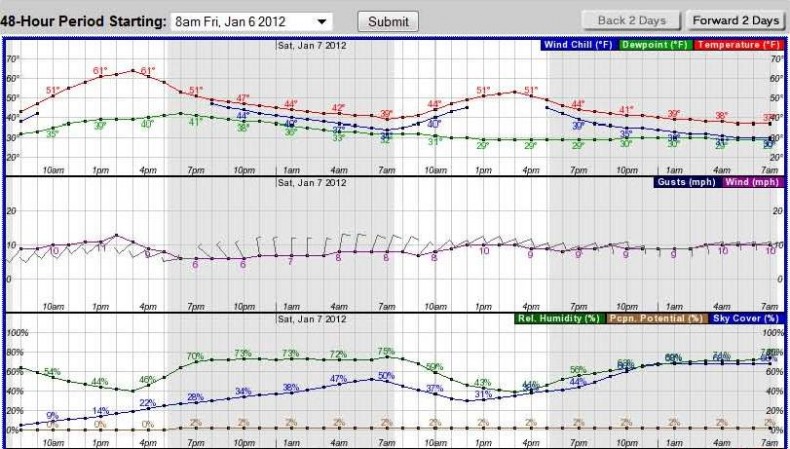How Weather Conditions Affect Hunting
Filed under: Deer Hunting, Hunting Blog
It’s warmer than normal across most of the whitetails’ range. Warm weather during January is usually associated with swirling winds. Looking at the weather forecast below, the wind direction will go around the compass during the next day or so at my place. That makes hunting conditions tough.

Hourly temperature prediction chart
However, that’s not the only ramification of warmer than normal temperatures this time of year to a deer hunter and manager. At this point in the season deer have a full fur coat. It was created to retain heat during extremely cold conditions for the area where those deer live (this is one reason deer shouldn’t be transported to new areas with different climatic conditions as they may not be adapted to thrive in the different conditions).
I don’t feel like moving much when I’m hot. Likewise, deer tend to limit their activity until the coolest times of the day when it’s hot relative to the normal conditions (60 in January when deer have a great fur coat probably makes them feel much hotter than when it’s 90 in July when they have a very thin summer coat). The coolest temperatures usually occur during nighttime. Hot temperatures during the late season encourage nocturnal activity. These factors make hunting deer very difficult during the late season when the temperatures are much warmer than normal for that time of year.
However, there are other considerations about warmer than normal temperatures during the winter. Deer ingest more food when they are colder – at least to a certain point. An exception is that if the temperatures get significantly colder than normal, deer tend to remain in cover and limit their activity.
Deer will produce larger antlers the following year if they consume more quality food (within limits) during the winter. It seems that warmer than normal temperatures probably result in deer consuming less food, and therefore potentially smaller antlers the following year.
I enjoyed walking to my stand yesterday without carrying bulky clothing. I never felt a chill the entire evening. Although I was comfortable, I would have gladly traded my comfort for colder temperatures and seeing deer during that hunt, and the hope of the local herd producing larger antlers and healthier fawns during 2012.
Slightly colder than normal temperatures during the late season probably result in better hunting, and healthier deer the following year. How are the weather conditions where you are hunting?
Growing Deer together,
Grant



